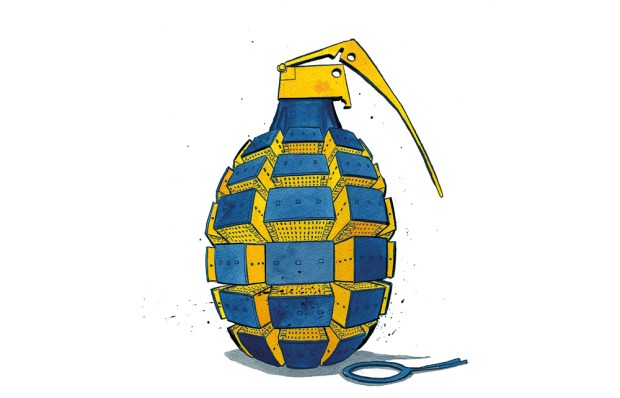The idea of dyeing a rhino’s horn pink is not absurd. It’s everything else about the 21st-century rhino-human interface that’s ridiculous. The pink-horn notion is a serious proposal and it’s as sane as the whole thing gets. There are plenty of other wacky notions out there. One is to drill a hole in a rhino’s horn and fill it with poison; the idea of the dye is to mark the horn as a poisoned one. Cutting the damn things off has also been tried. There are experiments that involve a horn-cam placed on a living rhino.
If you’re involved with rhino conservation, you’re waist-deep in brochures for drones. That’s the trendiest idea on the table: long-range surveillance without the need to step outside. Well, that’s the theory. There’s also work involving satellite imagery, predictive analysis, DNA analysis and GPS, and there is an enthusiastic group of people who want to develop and sell synthetic rhino horn. There are advanced plans for powder that’s ‘biologically identical’ to rhino horn, and others for a pretend horn that is ‘genetically similar’. There have been attempts to culture rhino horn from rhino DNA.
So there’s a great deal of science, a great deal of human ingenuity and all kinds of thrilling 21st-century thinking involved here — and it’s all lined up against the might of the fairies. For the rhino trade is based on exploded and pathetic ideas that are blood-brothers to flat-earthery, evolution-denial, Biblical literalism, pixies, ectoplasm and all the other bits of bottom-wiping nonsense we’re supposed to set aside before puberty.
But it’s a fact that all five species of rhino are charging pell-mell towards extinction because of an idea that’s proven bollocks. It’s also a fact that some great minds and serious money are lining up in the attempt to stop it. And here’s the cream of the jest: they’re losing. South Africa provides the most reliable and the most regularly quoted stats. In 2007 they lost 13 rhinos to illegal poaching. Last year they lost 1,215. Those figures are reflected elsewhere in Africa: it’s an increase of 9,000 per cent. At this rate we’ll be out of rhinos in about 20 years.
Most sharp declines and extinctions happen because the species in question finds itself in conflict with humans. Habitat destruction, the effects of intensive agriculture, increasing human population, demands for space: that’s an old story. But in Africa at least there’s still plenty of room for rhinos, and plenty of financial reasons for keeping them there: income from wildlife tourism is important in many African countries. But rhinos are constantly being killed because people believe in fairies.
Rhino horn is traditionally used in Chinese medicine to treat fevers and disorders of the blood. Never as an aphrodisiac: that’s a western fantasy. Fact: it doesn’t do anything. Not even harm. A rhino’s horn is made from keratin, like your fingernails. Next time you have a blood disorder, chew your fingernails.
Rhino-poaching for the Chinese medicine trade has been going on for years. The black rhino went nationally extinct in Zambia in the 1980s, though there’s now an excellent reintroduction programme. The trade in African rhinos has been increasing, not least because there are now many Chinese people working in Africa. Supply lines have been radically shortened, while the increasing prosperity in China put rhino horn within many more people’s range.
But now there is a further problem and it’s Vietnam. The place has gone nuts. Suddenly the country is full of wealthy middle-aged men and many of them require rhino horn to convince themselves that they’ve arrived. They use rhino horn to treat cancer; it’s also used to treat the after-effects of a night out. You can spend vast sums of money on a banquet and even more on your hangover: and the whole process shows just how far you’ve come in life. All this has led to the demented spike in rhino-poaching. This has been followed by complex and sometimes curious efforts to stop it — or at least cash in before they’ve all gone.
Much of it — at least on the fringes — is about a silver-bullet solution. So far that’s been elusive. For example, the pink dye isn’t permanent because it doesn’t permeate the horn; which is perhaps as well, because a pink horn affects the rhinos’ ability to hide from poachers. Poisoning horns doesn’t work for the same reason: the poison doesn’t get into the fibre of the horn itself, it stays in the drilled hole. Besides, the whole scheme is flawed by the irritating fact that the people who do the poaching are criminals. They’re not too worried about the health of the end-user or any other ethical problem of their business. Rhinos with poisoned horns have been poached.
The problem with synthetics is that the market is already awash with fake rhino horn, mostly powdered antelope horn, and this only drives up the desirability and price of the real thing. There is also a problem for the sellers: since neither real nor fake rhino horn does you any good, how do you market the stuff? And besides, we’re dealing with magic here. A rhino has to be sacrificed or there’s no point.
Drones aren’t the complete answer either, because they have limited range and can only be controlled in line of sight, and besides, their use is banned in some African countries. If there’s an answer, it’s probably not a bit of technology. It’s in political will in both the supply countries and the end-user countries. Africa needs scouts on the ground in increased numbers, with access to efficient modern transport — helicopters are best — for proactive and reactive operations. There have been great advances in intelligence gathering: getting ahead of the poachers.
The other step is in demand reduction. The excellent group Education for Nature-Vietnam is working hard on this. In one example they put out a public service broadcast in which the chanteuse Hong Nhung puts the case for rhinos beside a butchered animal in the African bush. In another, the comedian Chí Trung performs a sketch as a white-suited fat-cat showing off his rhino horn — only to be rejected by the girls he’s trying to impress.
So yes, it’s people, not technology, doing the best job right now. And the ideas keep coming. So long as people are working on the problem then there’s a possibility that some kind of solution can be found.
The business is a kind of lethal silliness. Graham Chapman interrupted Monty Python sketches when they got too silly: it’s high time he took the rhino trade in hand as well, for there are few things sillier on this earth than for a nice animal to become extinct over a hangover cure that doesn’t even work.
Got something to add? Join the discussion and comment below.
Get 10 issues for just $10
Subscribe to The Spectator Australia today for the next 10 magazine issues, plus full online access, for just $10.
Simon Barnes is a former chief sports writer of the Times and is a patron of Save the Rhino. Among his many books are Planet Zoo: 100 Animals We Can’t Afford to Lose and Ten Million Aliens.
You might disagree with half of it, but you’ll enjoy reading all of it. Try your first month for free, then just $2 a week for the remainder of your first year.














Comments
Don't miss out
Join the conversation with other Spectator Australia readers. Subscribe to leave a comment.
SUBSCRIBEAlready a subscriber? Log in